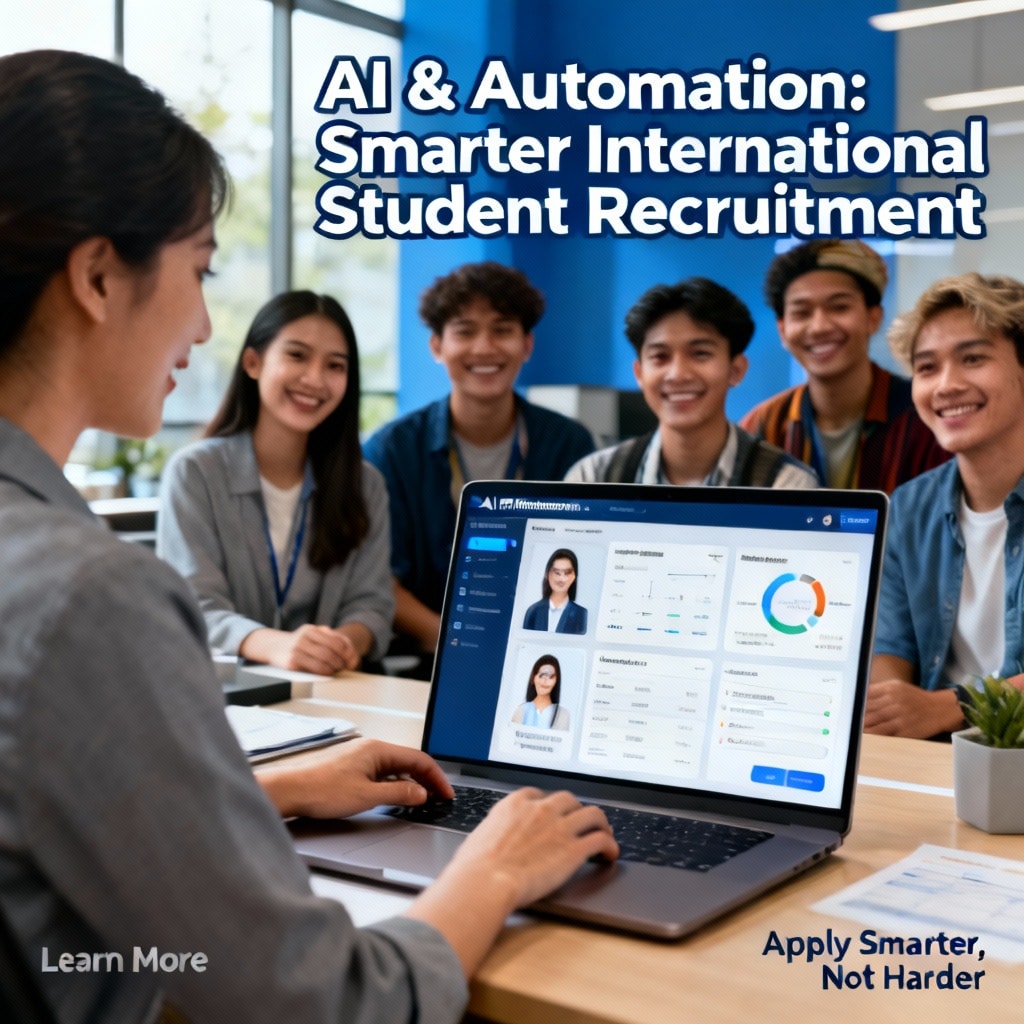AI and Automation in International Student Recruitment
- Why this trend matters now
- Key outcomes institutions are achieving
- Where AI and automation deliver the biggest impact
- Roadmap: How recruitment teams should pilot AI and automation
- Measuring success — KPIs and insights to track
- Common challenges and how to overcome them
- Take the Next Step with Study in Turkiye
Why this trend matters now
Global competition for international students is increasing as destinations diversify. Recruitment teams must respond faster and more personally. Prospective students expect immediate, multilingual responses and personalized pathways. Automation reduces manual workload, shortens application cycles, and improves conversion rates when applied correctly.
Key outcomes institutions are achieving with AI and automation
- Faster initial engagement: chatbots and instant response systems reduce response time from days to seconds.
- Improved lead qualification: automated scoring and predictive models identify high-propensity applicants.
- Higher application completion rates: workflow automation reminds applicants about documents, deadlines, and tests.
- Better resource allocation: admissions staff focus on complex cases and relationship-building, not repetitive tasks.
Where AI and automation deliver the biggest impact
1. Lead generation and qualification
AI-driven marketing automation can:
- Identify the highest-value digital channels for specific markets.
- Score leads automatically using behavioral signals (web visits, email opens, webinar attendance).
- Route hot prospects to counselors or agents instantly.
Actionable steps:
- Integrate website forms, social campaigns, and event registrations into a central CRM.
- Use predictive lead scoring frameworks and test thresholds for handoff to counselors.
- Local example: campuses that host virtual open days and integrate them with CRM systems report higher conversion from information seekers to applicants — a strategy easily deployed for programs at institutions like Ozyegin University and Bahcesehir University.
2. Conversational AI and multilingual support
Why it matters: International applicants expect instant, accurate answers in their language and time zone.
- Chatbots handle frequently asked questions (programs, tuition, scholarships, visa steps) and free admissions officers for personalized counseling.
Best practices:
- Deploy a multilingual chatbot trained on program-specific FAQs for medicine, engineering, and business.
- Integrate chat transcripts with CRM to create applicant profiles for personalized follow-up.
- Example: Health-focused programs at Medipol University and Istinye University benefit greatly from bots that provide early-stage guidance on clinical training, licensing, and language requirements.
3. Application screening and document verification
Capabilities:
- Optical character recognition (OCR) and AI-powered transcript evaluation speed up verification.
- Automated checks flag missing documents, academic equivalence issues, and basic fraud indicators.
Implementation tips:
- Start with automated completeness checks, then add AI verification for transcripts and diplomas.
- Link verification results into the application dashboard for adjudicators.
- Priority programs (e.g., medicine at Istinye University or Medipol University) demand rigorous document workflows — automate first-pass reviews to preserve staff time for detailed evaluation.
4. Personalized communications and nurturing
What works:
- Segmented drip campaigns that change content based on program of interest, nationality, academic profile, or stage in the funnel.
- Automated reminders for tests (YÖS, English exams), visa deadlines, and deposit dates.
Tactics:
- Use dynamic email templates and SMS that reference program details (e.g., clinical placement dates for health programs at Antalya Bilim University).
- Track opens and clicks to refine messaging and retarget undecided applicants.
5. Predictive enrollment modeling
Benefits:
- Predictive models estimate yield (the proportion of admitted students who enroll), allowing more precise offers and scholarship allocation.
- Models incorporate country trends, program competitiveness, and applicant behavior.
Steps to build:
- Collect historical yield and application data by country and program.
- Use simple models first (logistic regression) before deploying complex ML models.
- Continuously retrain models with each intake.
6. Virtual events and immersive experiences
Why they matter:
- Virtual fairs, recorded campus tours, and program webinars scale outreach without travel.
- Integration with registration systems provides lead capture and engagement analytics.
Examples and advice:
- Host program-specific webinars (e.g., psychology at Uskudar University or engineering at Yildiz Technical University).
- Use breakout rooms for regional counselors and sync event attendance to CRM for immediate follow-up.
Roadmap: How recruitment teams should pilot AI and automation
Phase 1 — Diagnose and prioritize (0–2 months)
- Map the applicant journey and identify time-consuming manual tasks.
- Define KPIs: lead response time, application completion rate, yield, cost per enrolled student.
Phase 2 — Pilot (2–6 months)
- Choose a high-impact, low-risk use case, such as a chatbot for FAQs or automated completeness checks.
- Select a small number of programs and source markets for testing (e.g., clinical tracks at Istinye University or business programs at Ozyegin University).
Phase 3 — Scale and optimize (6–18 months)
- Expand to predictive lead scoring and personalized nurture campaigns across programs.
- Integrate with CRM and admissions dashboards for unified reporting.
- Measure ROI and iterate.
Measuring success — KPIs and insights to track
- Lead response time (target: under 1 hour for initial contact).
- Application completion rate (increase by 10–30% with automation).
- Conversion rate from lead to applicant, and applicant to enrolled student.
- Time saved per admissions officer (hours/week).
- Cost per enrolled student.
Common challenges and how to overcome them
Challenge: Data silos across departments
Solution: Establish a single source of truth (CRM or SIS) and enforce consistent data entry protocols.
Challenge: Staff resistance to automation
Solution: Start with pilot projects that clearly demonstrate time savings and improved outcomes; include staff in design sessions.
Challenge: Complexity of international compliance and visas
Solution: Automate routine visa guidance while keeping legal counsel or visa specialists responsible for case-specific advice.
Take the Next Step with Study in Turkiye
AI and automation are not a silver bullet, but when deployed with a clear strategy they deliver measurable improvements in speed, personalization, and conversion. Partner with Study in Turkiye to design and implement a recruitment automation roadmap that aligns with institutional priorities and maximizes international reach.

